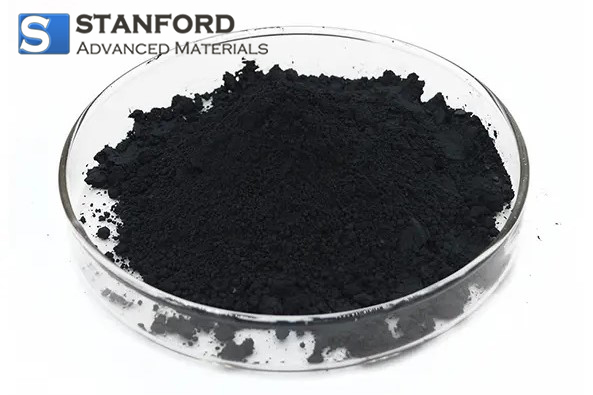SAFETY DATA SHEET
1. Identification
Product identifier Hafnium Nitride
Other means of identification
C 25817-87-2 AS number
Manufacturer/Importer/Supplier/Distributor information
Manufacturer: Stanford Advanced Materials (SAM)
Company name Address: 23661 Birtcher Dr., Lake Forest, CA 92630
United States
Telephone Supplier Phone: (949) 407-8904
Website: samaterials.com
E-mail: sales@samaterials.com
2. Hazard(s) identification Physical hazards
Health hazards
Not classified.
Not classified.
Environmental hazards Not classified.
OSHA defined hazards Not classified.
Label elements
Hazard symbol None.
Signal word None.
Hazard statement The substance does not meet the criteria for classification. Precautionary statement
Prevention Observe good industrial hygiene practices.
Response Wash hands after handling.
Storage Store away from incompatible materials.
Disposal Dispose of waste and residues in accordance with local authority requirements.
Hazard(s) not otherwise classified (HNOC)
None known.
Supplemental information 100% of the mixture consists of component(s) of unknown long-term hazards to the aquatic environment. 100% of the mixture consists of component(s) of unknown acute oral toxicity. 100%
of the mixture consists of component(s) of unknown acute hazards to the aquatic environment.
100% of the mixture consists of component(s) of unknown acute dermal toxicity.
3. Composition/information on ingredients
Substances
Chemical name Common name and synonyms CAS number % Hafnium Nitride 25817-87-2 100 - 100 *Designates that a specific chemical identity and/or percentage of composition has been withheld as a trade secret.
4. First-aid measures Inhalation
If breathing is difficult, remove to fresh air and keep at rest in a position comfortable for breathing. Call a physician if symptoms develop or persist.
Skin contact Rinse skin with water/shower. Get medical attention if irritation develops and persists. Eye contact Rinse with water. Get medical attention if irritation develops and persists. Ingestion Rinse mouth. If ingestion of a large amount does occur, call a poison control center immediately. Most importantly Direct contact with eyes may cause temporary irritation.
symptoms/effects, acute and
delayed
Indication of immediate medical Treat symptomatically.
attention and special treatment
needed
General information
5. Fire-fighting measures
Ensure that medical personnel are aware of the material(s) involved, and take precautions to protect themselves.
Suitable extinguishing media Water fog. Foam. Dry chemical powder. Carbon dioxide (CO2). Unsuitable extinguishing media Do not use a water jet as an extinguisher, as this will spread the fire. Specific hazards arising from fire, and gases hazardous to health may be formed.
Special protective equipment Self-contained breathing apparatus and full protective clothing must be worn in case of fire. and precautions for firefighters
Fire fighting Move containers from the fire area if you can do so without risk. equipment/instructions
Specific methods Use standard firefighting procedures and consider the hazards of other involved materials. General fire hazards No unusual fire or explosion hazards were noted.
6. Accidental release measures
Personal precautions, protective Keep unnecessary personnel away. For personal protection, see section 8 of the SDS. equipment and emergency procedures. Methods and materials for containment and cleaning up.
Stop the flow of material, if this is without risk. Following product recovery, flush area with water. For waste disposal, see section 13 of the SDS.
Environmental precautions Avoid discharge into drains, water courses or onto the ground.
7. Handling and storage
Precautions for safe handling Avoid prolonged exposure. Use care in handling/storage.
Conditions for safe storage, including any incompatibilities
Store in the original tightly closed container. Store away from incompatible materials (see Section 10 of the SDS).
8. Exposure controls/personal protection
Occupational exposure limits
US. ACGIH Threshold Limit Values
Material Type Value
Hafnium Nitride (CAS TWA 0.5 mg/m3 25817-87-2)
US. NIOSH: Pocket Guide to Chemical Hazards
Material Type Value
Hafnium Nitride (CAS TWA 0.5 mg/m3 25817-87-2)
Biological limit values No biological exposure limits noted for the ingredient(s).
Appropriate engineering controls
Good general ventilation (typically 10 air changes per hour) should be used. Ventilation rates should be matched to conditions. If applicable, use process enclosures, local exhaust ventilation, or other engineering controls to maintain airborne levels below recommended exposure limits. If exposure limits have not been established, maintain airborne levels to an acceptable level.
Control parameters Follow standard monitoring procedures.
Individual protection measures, such as personal protective equipment
Eye/face protection Wear safety glasses with side shields (or goggles).
Skin protection
Hand protection Wear appropriate chemical resistant gloves.
Other Wear suitable protective clothing.
Respiratory protection In case of insufficient ventilation, wear suitable respiratory equipment. Thermal hazards Wear appropriate thermal protective clothing, when necessary.
General hygiene considerations
Always observe good personal hygiene measures, such as washing after handling the material and before eating, drinking, and/or smoking. Routinely wash work clothing and protective equipment to remove contaminants.
9. Physical and chemical properties Appearance
Physical state Solid.
Form Solid.
Color Not available. Odor Not available. Odor threshold Not available. pH Not available. Melting point/freezing point Not available.
Initial boiling point and boiling range
Not available.
Flash point Not available. Evaporation rate Not available. Flammability (solid, gas) Not available. Upper/lower flammability or explosive limits
Flammability limit - lower (%)
Flammability limit - upper (%)
Not available. Not available.
Explosive limit - lower (%) Not available.
Explosive limit - upper (%) Not available.
Vapor pressure < 0.0000001 kPa at 25 °C Vapor density Not available. Relative density Not available. Solubility(ies)
Solubility (water) Not available.
Partition coefficient (n-octanol/water)
Not available.
Auto-ignition temperature Not available. Decomposition temperature Not available. Viscosity Not available.
Other information
Explosive properties Not explosive.
Molecular formula HfN
Oxidizing properties Not oxidizing.
10. Stability and reactivity
Reactivity The product is stable and non-reactive under normal conditions of use, storage, and transport. Chemical stability Material is stable under normal conditions.
Possibility of hazardous No dangerous reaction is known under conditions of normal use. reactions
Conditions to avoid Contact with incompatible materials.
Incompatible materials Strong oxidizing agents.
Hazardous decomposition No hazardous decomposition products are known.
products
11. Toxicological information
Information on likely routes of exposure
Inhalation Prolonged inhalation may be harmful.
Skin contact No adverse effects due to skin contact are expected.
Eye contact Direct contact with eyes may cause temporary irritation.
Ingestion is Expected to be a low ingestion hazard.
Symptoms related to the
physical, chemical and
toxicological characteristics Information on toxicological effects
Direct contact with the eyes may cause temporary irritation.
Acute toxicity is Not known.
Skin corrosion/irritation Prolonged skin contact may cause temporary irritation. Serious eye damage/eye Direct contact with eyes may cause temporary irritation. irritation
Respiratory or skin sensitization
Respiratory sensitization Not a respiratory sensitizer.
Skin sensitization This product is not expected to cause skin sensitization.
Germ cell mutagenicity
No data is available to indicate product or any components present at greater than 0.1% are mutagenic or genotoxic.
Carcinogenicity This product is not considered to be a carcinogen by IARC, ACGIH, NTP, or OSHA. IARC Monographs. Overall Evaluation of Carcinogenicity
Not listed.
US. National Toxicology Program (NTP) Report on Carcinogens
Not listed.
US. OSHA Specifically Regulated Substances (29 CFR 1910.1001-1050)
Not regulated.
Reproductive toxicity This product is not expected to cause reproductive or developmental effects.
Specific target organ toxicity - single exposure
Specific target organ toxicity - repeated exposure
Not classified. Not classified.
Aspiration hazard Not an aspiration hazard.
Chronic effects Prolonged inhalation may be harmful. Further information This product has no known adverse effect on human health.
12. Ecological information Ecotoxicity
The product is not classified as environmentally hazardous. However, this does not exclude the possibility that large or frequent spills can have a harmful or damaging effect on the environment.
Persistence and degradability No data is available on the degradability of this product.
Bioaccumulative potential No data available.
Mobility in soil No data available.
Other adverse effects No other adverse environmental effects (e.g. ozone depletion, photochemical ozone creation potential, endocrine disruption, global warming potential) are expected from this component.
13. Disposal considerations
Disposal instructions Collect and reclaim or dispose in sealed containers at licensed waste disposal site. Local disposal regulations Dispose in accordance with all applicable regulations.
Hazardous waste code
Waste from residues / unused products
Contaminated packaging
14. Transport information DOT
The waste code should be assigned in discussion between the user, the producer and the waste disposal company.
Dispose of in accordance with local regulations. Empty containers or liners may retain some product residues. This material and its container must be disposed of in a safe manner (see: Disposal instructions).
Since emptied containers may retain product residue, follow label warnings even after container is emptied. Empty containers should be taken to an approved waste handling site for recycling or disposal.
Not regulated as dangerous goods. IATA
Not regulated as dangerous goods. IMDG
Not regulated as dangerous goods. 15. Regulatory information
US federal regulations
This product is not known to be a "Hazardous Chemical" as defined by the OSHA Hazard Communication Standard, 29 CFR 1910.1200.
TSCA Section 12(b) Export Notification (40 CFR 707, Subpt. D) Not regulated.
CERCLA Hazardous Substance List (40 CFR 302.4)
Not listed.
US. OSHA Specifically Regulated Substances (29 CFR 1910.1001-1050) Not regulated.
Superfund Amendments and Reauthorization Act of 1986 (SARA)
Hazard categories
Immediate Hazard - No Delayed Hazard - No Fire Hazard - No
Pressure Hazard - No Reactivity Hazard - No
SARA 302 Extremely hazardous substance Not listed.
SARA 311/312 Hazardous Yes chemical
SARA 313 (TRI reporting)
Not regulated.
Other federal regulations
Clean Air Act (CAA) Section 112 Hazardous Air Pollutants (HAPs) List Not regulated.
Clean Air Act (CAA) Section 112(r) Accidental Release Prevention (40 CFR 68.130) Not regulated.
Safe Drinking Water Act Not regulated.
(SDWA)
US state regulations
California Safe Drinking Water and Toxic Enforcement Act of 1986 (Proposition 65): This material is not known to contain any chemicals currently listed as carcinogens or reproductive toxins.
16. Other information, including date of preparation or last revision
Issue date
Version #
Disclaimer
Material name: Hafnium Nitride
11-24-2023
03
Stanford Advanced Materials Group cannot anticipate all conditions under which this information and its product, or the products of other manufacturers in combination with its product, may be used. It is the user’s responsibility to ensure safe conditions for handling, storage, and disposal of the product, and to assume liability for loss, injury, damage, or expense due to improper use.











